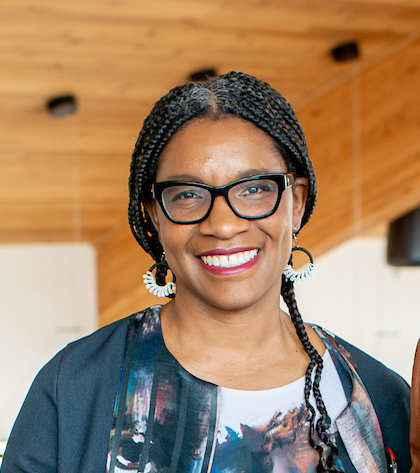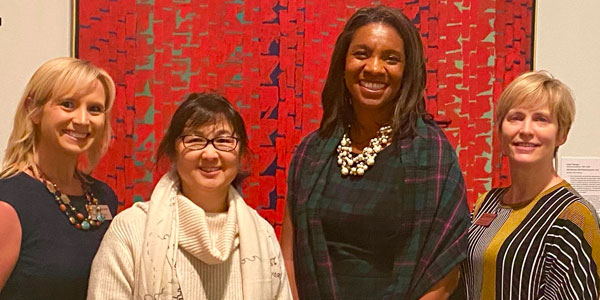A Message from Director Erika George
 Dear Tanner Humanities Community,
Dear Tanner Humanities Community,
I hope my message finds you and yours safe and well. As the world continues to cope
with the uncertainty caused by the novel Coronavirus (COVID-19) we continue to keep
you in our thoughts.
While the center remains closed to ensure the safety of our staff and patrons, we’ve
been excited to see how open members of our community have been to finding new ways
to celebrate significant arts, culture, and humanities occasions. Last month marked
the 50th anniversary of Earth Day and of Utah’s renowned work of land art—the “Spiral Jetty.”
The first Earth Day in 1970 has been credited with creating the modern environmental
movement as well as generating the political will to pass environmental protection
laws. Despite the global pandemic and physical distancing, people from around the
world came together to celebrate a digital Earth Day in 2020. Scientists predict that
the pandemic could cause a historic drop in carbon emissions. The skies above Salt
Lake City have appeared clearer to me in recent weeks.
Just two hours outside Salt Lake City is one of the most important works of “land
art” in the world—Robert Smithson’s Spiral Jetty in the Great Salt Lake State Park.
I’ve learned that Smithson was interested in entropy, impermanence, and change. He
intended for his art to be experienced at a massive scale to move us to examine our
perspective and our sense of place. Recently, I’ve been reflecting on the enormity
of the rapid changes global pandemic has presented, our place on the planet, what
we must change, and the type of world we will create. Amidst the Coronavirus, I am
comforted to know that creators are continuing to create. I’ve been especially intrigued
by the connections being made between the digital humanities and environmentalists
during physical distancing.
When artist, architect, designer and environmentalist Maya Lin visited Utah to deliver
the Tanner Lecture on Human Values last November we talked about the significance
of the Spiral Jetty and her creative process. She continues work on her new project
“What’s Missing” a global digital memorial to the planet. Best known for designing
the Vietnam Veterans Memorial in Washington, D.C., Lin made history and caused controversy.
Sadly, it was her heritage that proved a problem for some of her critics.

(From left to right) Beth James, Associate Director;
Maya Lin, 2019 Tanner Lecturer; Erika George, Director;
Susan Anderson, Development Officer
May is Asian American and Pacific Islander History Month, an opportunity for us to
celebrate the contributions of Asians and Pacific Islanders in the US. This month
also commemorates the immigration of the first Japanese to the US in 1843 and the
completion of the transcontinental railroad in 1869. The majority of the laborers
that laid the railroad tracks were Chinese immigrants. Lin is the daughter of Chinese
intellectuals who fled China in 1948 and migrated to the US.
Documented incidents of racist hate crimes targeting Asians have surged recently as
Covid19 spreads because a portion of the public has come to associate the Coronavirus
with a particular ethnic group. Stereotypes combined with the stigma of a deadly disease
have the power to harm. Former Tanner Fellow Paisley Rekdal explains how in her recent
commentary available here.
While I truly worry about the virulent spread of racism worldwide, I continue to believe
the present crisis offers us an opportunity to deepen our capacity for empathy and
to enrich our understanding of one another and the world we share. To that end, I
am especially proud of the involvement of our research fellows in advancing public
inquiry and exchange.
Until we can safely go back to the center we will be looking back and sharing recent
news about the people and programs that make the center such a special place. This
month we feature a conversation with Gretchen Henderson, our former Annie Clark Tanner
Fellow in Environmental Humanities. Among other things, she tells us about land art,
the Great Salt Lake’s tar seeps, and her love for the geologic aesthetics of Utah.
I believe the capacities we acquire through exposure to the humanities are essential
to confronting catastrophes and coming to terms with uncertainty. Center partner Jeffrey
McCarthy, Director of Environmental Humanities recently penned a commentary exploring what the humanities can teach us about ourselves and our society. Indeed,
as he writes: “There can be…no ethical or epidemiological escape from the shared condition
of our community.”
Thank you for being a part of our community. We value our relationship with you and
we appreciate your support. We look forward to seeing you again in person.
Please follow us on social media for our updates and information on arts and culture
activities available to you online. Please feel free to contact us to share your ideas.
We would love to hear from you.
